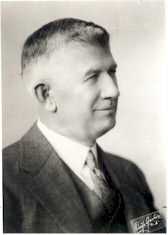Work on loading coils
In 1897 Campbell went to work for AT&T in Boston. He developed a method for transmitting analog telephony over much greater distances than had previously been possible by the insertion of loading coils into the line at carefully calculated intervals to increase the inductance. Engineer Michael I. Pupin also patented a similar system and AT&T paid Pupin a very large sum for his patents, so that development would continue without a legal battle. In fact, neither man was the first to suggest the idea of loading coils, that credit goes to Oliver Heaviside in an 1887 article. Heaviside, however, never patented the idea; indeed, he took no commercial advantage of any of his brilliant work. Despite the rather arcane legal arguments surrounding this, it is unquestionable that Campbell was the first to actually construct a telephone circuit using loading coils.
Campbell was aware of Heaviside's work in discovering the Heaviside condition, in which the specification for distortionless transmission of signals is formulated, but apparently was not aware of Heaviside's suggestion of using loading coils to force a line to meet it. Campbell initially attacked the problem from a completely different basis. Campbell was tasked by AT&T to investigate the possibility of improving line quality with the use of iron-copper bimetallic cable invented by John S. Stone, another AT&T engineer. This cable of Stone's would similarly increase line inductance and had the potential to meet the Heaviside condition. However, Campbell was struggling to set up a practical demonstration over a real telephone route with the budget he had been allocated. After considering that his artificial line simulators used lumped components rather than the distributed quantities found in a real line, he wondered if he could not insert the inductance with lumped components instead of using Stone's distributed line. When his calculations showed that the manholes on telephone routes were sufficiently close together to be able to insert the loading coils without the expense of either having to dig up the route or lay in new cables he changed to this new plan. The very first demonstration of loading coils on a telephone cable was on a 46-mile length of the so-called Pittsburgh cable (the test was actually in Boston, the cable had previously been used for testing in Pittsburgh) on September 6, 1899, carried out by Campbell himself and his assistant. The first telephone cable using loaded lines put into public service was between Jamaica Plain and West Newton just outside of Boston on May 18, 1900.
Legal battle
AT&T fought a legal battle with Pupin over his claim. Pupin was first to patent but Campbell had already conducted practical demonstrations before Pupin had even filed his patent (December 1899), Campbell's delay in filing being due to the slow internal machinations of AT&T. The claim Pupin makes in his autobiography that he had previously thought of the idea while climbing a mountain in 1894 is widely doubted and there is no evidence for this either documentary or in the subsequent activities of Pupin and his students. However, AT&T foolishly deleted from Campbell's proposed patent application all the tables and graphs detailing the exact value of inductance that would be required before the patent was submitted. Since Pupin's patent contained a (less accurate) formula, AT&T was open to claims of incomplete disclosure. Fearing that there was a risk that the battle would end with the invention being declared unpatentable (due to Heaviside's prior work), they decided to buy an option on Pupin's patent for a yearly fee so that AT&T would control both patents. By January 1901 Pupin had been paid $200,000 (equivalent to $5,850,000 in 2023) and by 1917, when the AT&T monopoly ended and payments ceased, he had received a total of $455,000 (equivalent to $11,040,000 in 2023).
The invention was of enormous value to AT&T. Telephone cables could now be used to twice the distance previously possible, or alternatively, a cable of half the previous quality (and cost) could be used over the same distance. When considering whether to allow Campbell to go ahead with the demonstration, their engineers had estimated that they stood to save $700,000 (equivalent to $21,700,000 in 2023) in new installation costs in New York and New Jersey alone. It has been estimated that AT&T saved $100 million (3.1 billion in 2023) in the first quarter of the 20th century. Heaviside, who began it all, came away with nothing. He was offered a token payment but would not accept, wanting the credit for his work rather than money. He remarked ironically that if his prior publication had been admitted it would "interfere...with the flow of dollars in the proper direction...".
